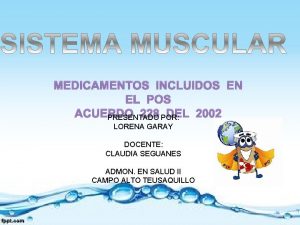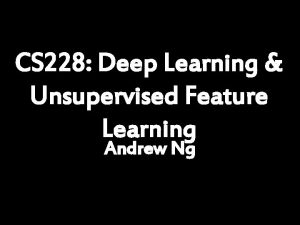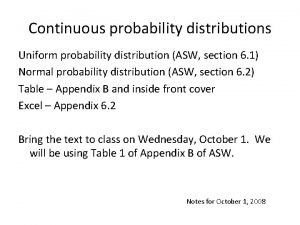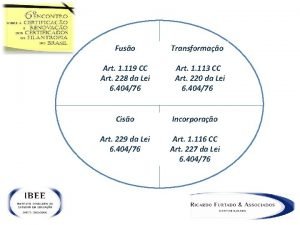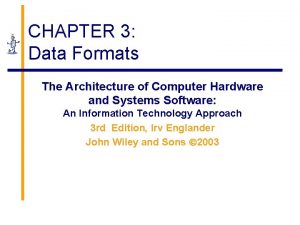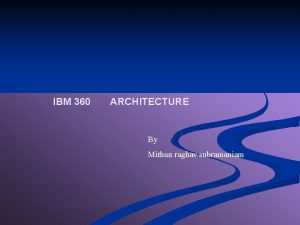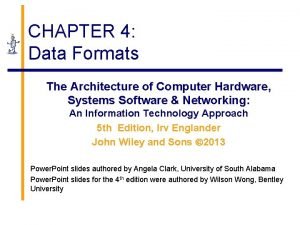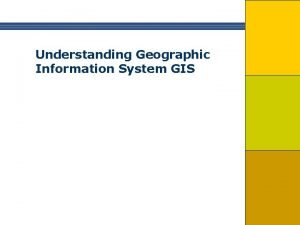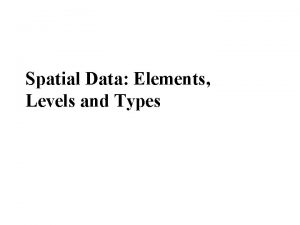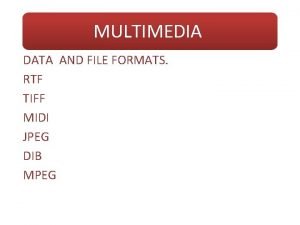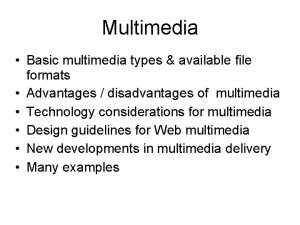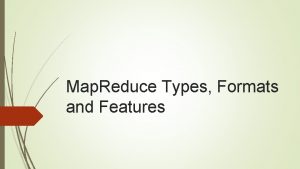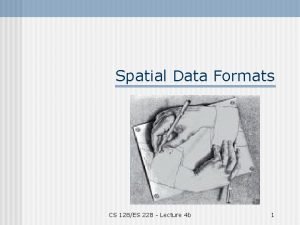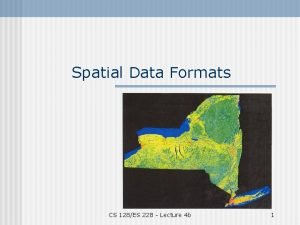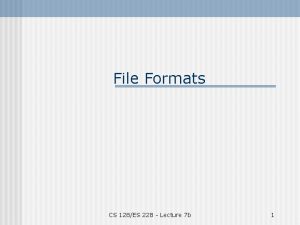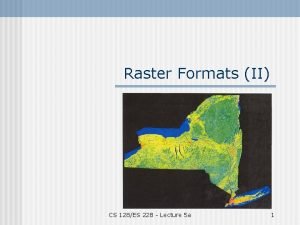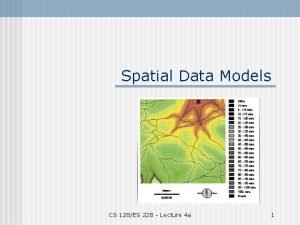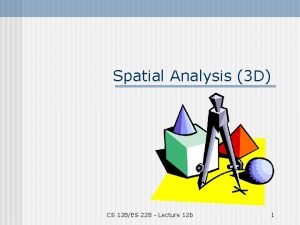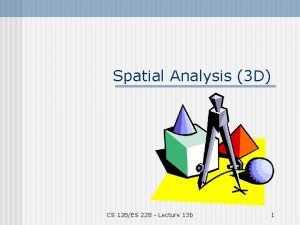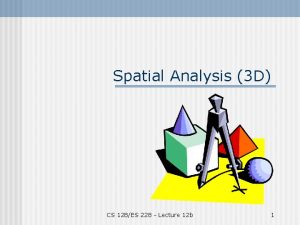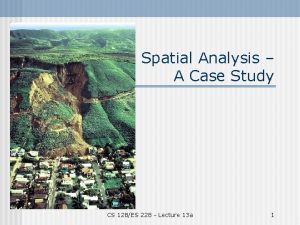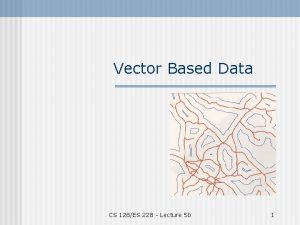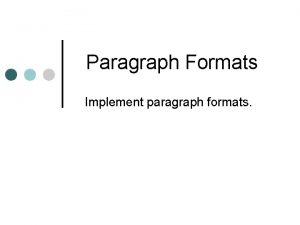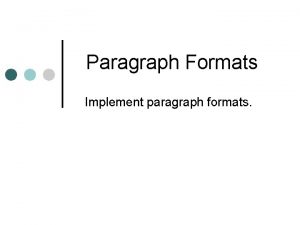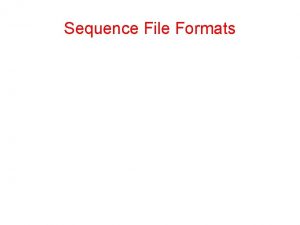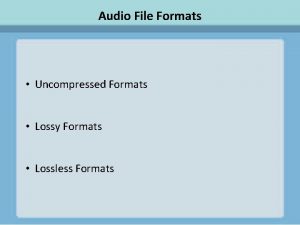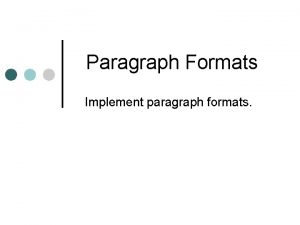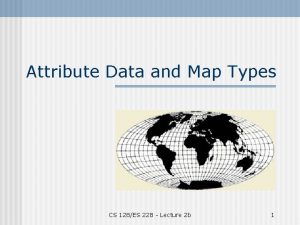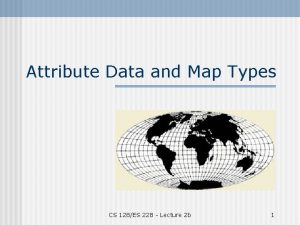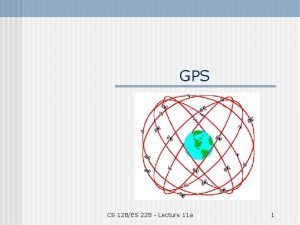Spatial Data Formats CS 128ES 228 Lecture 4




















- Slides: 20

Spatial Data Formats CS 128/ES 228 - Lecture 4 b 1

Stages of development: 1. Conceptual model: select the features of reality to be modeled and decide what entities will represent them 2. Spatial data model: select a format that will represent the model entities 3. Spatial data structure: decide how to code the entities in the model’s data files CS 128/ES 228 - Lecture 4 b 2

2. Spatial data models Spatial data formats: 1. Raster 2. Vector 3. Objectoriented 4. Attribute data CS 128/ES 228 - Lecture 4 b 3

Raster format § Features represented by cell contents § Spatial precision limited by cell size § Surfaces modeled as continuous values (almost) CS 128/ES 228 - Lecture 4 b 4

Vector format § Discrete features explicitly represented § Spatial precision limited by number format § Surfaces shown by contours rather than continuous values CS 128/ES 228 - Lecture 4 b 5

Object-oriented formats Leave details for CS majors CS 128/ES 228 - Lecture 4 b 6

Thematic data (a. k. a. “attribute data”) n Quantitative or descriptive n May represent 1 or many themes n Tied to a spatial reference n Represented differently in raster vs. vector formats CS 128/ES 228 - Lecture 4 b 7

Scales of measurement Data Unit Scale Resort name text Nominal Resort ranking value Ordinal Winter temp. o. C Interval Size of ski area m 2 Ratio Heywood et. al. 2002 – Table 2. 1 CS 128/ES 228 - Lecture 4 b 8

Spatial modeling in raster format § Basic entity is the cell § Region represented by a tiling of cells § Cell size = resolution § Attribute data linked to individual cells CS 128/ES 228 - Lecture 4 b 9

Attribute data in raster format Attribute data used to create symbology for each cell CS 128/ES 228 - Lecture 4 b 10

Additional attribute data § Some GISs provide a VAT linked to individual cells (e. g. Arc. Info GRID) § VAT data then accessible to database management system Unlimited additional fields CS 128/ES 228 - Lecture 4 b 11

Attribute data for a vector layer § Each point linked to a row in an attribute table § Themes not (usually) displayed but available via Identify tool CS 128/ES 228 - Lecture 4 b 12

Tesselation n A closed shape or polygon that repeats on all sides without any gaps or overlaps n Three regular polygons tesselate the plane: Square Equilateral triangle CS 128/ES 228 - Lecture 4 b Hexagon 13

Tilings In 1922 Escher visited the Alhambra palace and saw the wall tilings of the Moors. He was excited to find other artists who had been captivated by tilings, but also made this revealing comment: "What a pity their religion forbade them to make graven images. " CS 128/ES 228 - Lecture 4 b 14

Escher’s “tesselations” CS 128/ES 228 - Lecture 4 b 15

Quilters also tesselate Designing Tesselations by Jinny Beyer CS 128/ES 228 - Lecture 4 b 16

Effects of resolution – raster Larger cells: § less precise spatial fix § line + boundary thickening § features too close overlap - less detail possible CS 128/ES 228 - Lecture 4 b 17

Advantages of raster format many data sets available § different file formats n easy to overlay multiple themes n n able to represent multiple continuous surfaces n readily interconverted fast computer lookup and display CS 128/ES 228 - Lecture 4 b 18

Limitations of raster format § poor representation of discrete objects n n exact boundary location difficult constant resolution throughout region modeled n difficult to change projection or coordinate system n generates very large data sets CS 128/ES 228 - Lecture 4 b 19

Summary: Raster format n A huge amount of spatial data are available in raster format n Rasters are the format of choice for continuous features n Rasters do a poor job of representing discrete features CS 128/ES 228 - Lecture 4 b 20
 Spatial data vs non spatial data
Spatial data vs non spatial data Acuerdo 228 medicamentos pos
Acuerdo 228 medicamentos pos Cs 228
Cs 228 Asw 228
Asw 228 Eaf 228
Eaf 228 Romiešu jurists 170-228
Romiešu jurists 170-228 Hymn 228
Hymn 228 Fuso art
Fuso art List various rapid prototyping data formats
List various rapid prototyping data formats Computer data format
Computer data format Data formats of ibm 360/370 machine in system programming
Data formats of ibm 360/370 machine in system programming Data formats in computer architecture
Data formats in computer architecture Spatial data and attribute data
Spatial data and attribute data Spatial data and attribute data
Spatial data and attribute data 01:640:244 lecture notes - lecture 15: plat, idah, farad
01:640:244 lecture notes - lecture 15: plat, idah, farad Movie maker file formats
Movie maker file formats Rtf file format was introduced by
Rtf file format was introduced by File formats in multimedia
File formats in multimedia Map reduce types
Map reduce types Html
Html Input formats in hadoop
Input formats in hadoop

